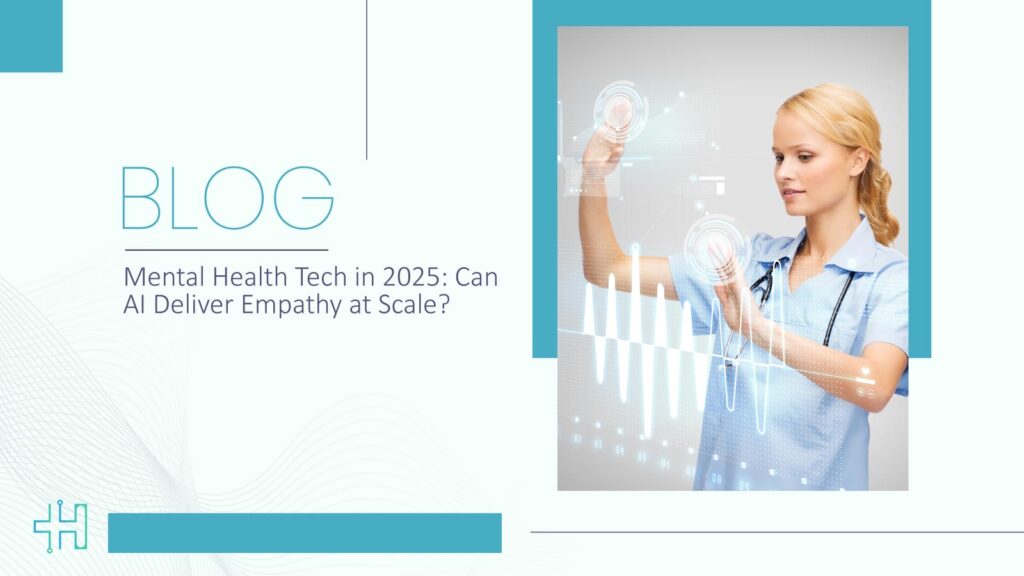We exist in a rapidly moving world, but mental health is not always keeping up. Technology has been innovating industries year by year, while mental health has long followed in its wake. That’s now changing. In 2025, mental health technology is driving significant change, with AI at the helm of this transformation.
We’ve moved past asking if AI is capable of sensing human emotions or supporting mental well-being. It’s this: Does AI have what it takes to deliver empathy at scale?
We need to have this conversation, as tech players, as disruptors, as human beings. So, let’s see where we are today, what works well, and where we need some improvement with AI-fueled mental health offerings.
The Rise of Mental Health Technology
We’ve all seen the growing demand for mental health services. The challenges of post-pandemic stress, workplace burnout, and social isolation have led many individuals to turn to support for assistance. However, a major challenge exists: there simply aren’t enough mental health professionals to keep up with the growing demand.
That’s where mental health tech comes in. Digital therapy apps, chatbots, mood trackers, and AI-powered virtual assistants are attempting to fill the gap. And while they’re not a replacement for an actual therapist, they’re allowing people to reach help sooner than ever.
How AI Is Powering Mental Health Tools
AI powers most mental health platforms. It examines trends, detects risks, and even conducts conversations using Natural Language Processing (NLP).
Here’s what AI excels at:
- Early warning indicators, whether in written text, voice, or behavioral patterns—are identified with precision.
- Support is tailored to each individual’s emotions, actions, and prior interactions.
- Around-the-clock access to emotional support ensures help is always available.
- Users can be guided through CBT (Cognitive Behavioral Therapy) workouts as part of their wellness journey.
- By offering anonymous assistance, the system helps eliminate the stigma often associated with seeking help.
Apps such as Woebot, Wysa, and Tess are already leveraging AI to provide chatbot-based support. These aren’t therapists, but they are accessible, scalable, and there when people need them most.
The Problem With Empathy
This is the hard part: empathy is human. It’s a feeling, not a function. AI can mimic caring words. It might use emotion-detecting algorithms to choose reassuring language, but does it truly comprehend the depth of human suffering?
Not yet. And perhaps never fully. Nevertheless, that does not mean AI can’t be therapeutic. Even when customers are aware they’re conversing with a machine, the process of conveying emotion can be therapeutic. Indeed, many customers indicate experiencing “heard” and “seen” by their digital friends.
Where AI Works Well
Okay, let’s discuss where mental health tech and AI are already performing well.
- Preventative Care. Intelligent systems, driven by advanced algorithms, can therefore detect subtle behavior shifts that may point to emerging mental well-being concerns. For instance, deviations in language patterns, sleep pattern monitoring, or social isolation.
- Emergency Response. Some platforms employ AI to identify indicators of suicidal ideation. Where this happens, they can bring it up with a human therapist or emergency contact promptly.
- Ongoing Monitoring. Chronic illnesses such as depression or anxiety can be monitored over time using AI. That makes treatment more routine and quantifiable.
Limitations We Can’t Ignore
Although the technology is impressive, it is not without its flaws.
- Bias in data: AI only learns what it’s been trained on. That usually means minority or underserved populations are left out.
- Privacy issues: Mental health information is very personal. Although the technology is impressive, it is not without its flaws.
- Limited understanding of emotions: AI often struggles to interpret tone, sarcasm, or subtle emotional cues.
These are real limitations, and we must address them before scaling too quickly.
What Tech Leaders Need to Prioritize
As tech workers, we have a duty. If we’re creating or investing in mental health tech, we must:
- Prioritize ethical AI by utilizing varied data sources and ensuring transparency in decision processes.
- Add human supervision – Always provide a human backstop. Humans require actual conversations at times.
- Prioritize accessibility – Design tools to be accessible to all ages, abilities, and backgrounds.
- Moreover, confidential handling of mental wellness data demands scrupulous safeguarding through encryption, identity masking, and thoughtful discretion.
The destiny of mental health technology relies on how we develop it.
AI Being Used in Mental Health in Real Life
Let’s take some real examples of use cases in 2025:
- Woebot applies AI to provide everyday mental health check-ins. It adjusts the conversation by the user’s mood and behavior.
- Headspace offers chat-based mental health guidance and escalates to therapy if necessary. AI assists in triaging user needs.
- Tess assists users through SMS, curating responses with NLP. It’s implemented in universities and hospitals.
- Replika applies AI to mimic emotional dialogue with users who want companionship or emotional support.
All the platforms employ AI in a different manner—but all work to extend empathy, even if they can’t do it perfectly.
The Future: Human-AI Collaboration
We don’t believe AI will replace human therapists. Rather, it will complement them.
Therapists in the future may use AI to keep an eye on patients between sessions. Chatbots can provide basic emotional support, while therapists deal with more complicated cases. That balance is where we see the most value.
It’s not a matter of AI or humans; rather, it’s a matter of using both intelligently. In 2025, mental health technology is indeed making waves. Specifically, AI is assisting us in reaching more individuals, providing quicker assistance, and tailoring support. At the same time, safeguard personal boundaries, yet remember, genuine understanding remains uniquely human
We believe artificial intelligence has the potential to expand access on a larger scale. But empathy? That’s always going to be human.
Frequently Asked Questions
- Can AI replace therapists?
No. AI can augment therapy, not replace it. It serves most effectively as an addition, rather than a replacement.
- Is mental health data safe with AI apps?
Only if there are proper encryption and privacy measures in place.
- How does AI know someone is in distress?
AI considers language usage, tone, typing rate, and so on. If risk factors appear, some platforms refer to a human.
- Are AI therapy apps useful?
Yes, especially for low to moderate difficulties. Infact, relief through frequent check-ins and cognitive drills advised by AI is reportedly experienced by many users.
- Which mental health technology platforms are set to adopt AI advancements in 2025?
A few of the popular platforms in this space are Woebot, Wysa, Tess, Replika, and Headspace.
Ready to Explore Mental Health Tech?
To participate in our interviews, please write to our HealthTech Media Room at sudipto@intentamplify.com






